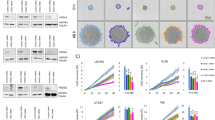Abstract
To examine the role of p57KIP2 in human malignant glioma cells, we studied its expression in a panel of human malignant glioma specimens by western blot and immunohistochemical analysis. To determine the effects of p57KIP2 expression on the phenotype of glioma cells, we analyzed two inducible stably transfected p57KIP2 expressing glioma cell lines. Expression of p57KIP2 was induced in U373 and U87 malignant gliomacells with doxycycline using the tetracycline repressor system. A phagokinetic track assay on gold particles was used to investigate differences in cell migration between p57KIP2 expressing and non-expressing control cells. The effects of the extracellular matrix (ECM) on U373 motility was determined in p57+ and p57− cells on surfaces coated with 5 μg/cm2 of fibronectin, laminin, type I and type IV collagens. The invasion of p57+ and p57− glioma cells across BD Biocoat Matrigel invasion chambers was then determined. p57KIP2 was weakly expressed in 4/6 glioblastoma (GBM) specimens by western blot. By immunohistochemistry, p57KIP2 immunoreactivity was positive in 8/40 GBMs, and was primarily nuclear in location. The motility of U373 glioma cells was significantly reduced after p57KIP2 induction. The presence of ECM proteins did not further alter the motility of p57+ and p57− glioma cells. The results of the invasion chamber assay showed that p57+ cells exhibited a 35% reduction in their invasive capacity as compared to p57− cells. These data suggest that p57KIP2 is expressed in at least some malignant gliomas. Inducible expression of 57KIP2 in cell lines deficient in this cyclin-dependent kinase inhibitor reduces their motility and invasiveness.
Similar content being viewed by others
References
Holland EC: Glioblastoma multiforme: the terminator. Proc Natl Acad Sci USA 97: 6242–6244, 2000
Louis DN, Holland EC, Cairncross JG: Glioma classification: a molecular reappraisal. Am J Pathol 159: 779–786, 2001
Dirks PB, Hubbard SL, Murakami M, Rutka JT: Cyclin and cyclin-dependent kinase expression in human astrocytoma cell lines. J Neuropathol Exp Neurol 56: 291–300, 1997
Dirks PB, Rutka JT: Current concepts in neuro-oncology: the cell cycle — a review. Neurosurgery 40: 1000–1013, 1997 (discussion 1013–1005)
Tsugu A, Sakai K, Dirks PB, Jung S, Weksberg R, Fei YL, Mondal S, Ivanchuk S, Ackerley C, Hamel PA et al.: Expression of p57(KIP2) potently blocks the growth of human astrocytomas and induces cell senescence. Am J Pathol 157: 919–932, 2000
Mainprize TG, Taylor MD, Rutka JT, Dirks PB: Cip/Kip cell-cycle inhibitors: a neuro-oncological perspective. J Neurooncol 51: 205–218, 2001
Matsuoka S, Edwards MC, Bai C, Parker S, Zhang P, Baldini A, Harper JW, Elledge SJ: p57KIP2, a structurally distinct member of the p21CIP1 Cdk inhibitor family, is a candidate tumor suppressor gene. Genes Dev 9: 650–662, 1995
Giese A, Loo MA, Rief MD, Tran N, Berens ME: Substrates for astrocytoma invasion. Neurosurgery 37: 294–301, 1995 (discussion 301–292)
Yoshizato K, Zapf S, Westphal M, Berens ME, Giese A: Thromboxane synthase inhibitors induce apoptosis in migration-arrested glioma cells. Neurosurgery 50: 343–354, 2002
Westermark B, Ponten J, Hugosson R: Determinants for the establishment of permanent tissue culture lines from human gliomas. Acta Pathol Microbiol Scand [A] 81: 791–805, 1973
Baron U, Gossen M, Bujard H: Tetracycline-controlled transcription in eukaryotes: novel transactivators with graded transactivation potential. Nucleic Acids Res 25, 2723–2729, 1997
Gossen M, Bujard H: Studying gene function in eukaryotes by conditional gene inactivation. Annu Rev Genet 36: 153–173, 2002
Gossen M, Bujard H: Tight control of gene expression in mammalian cells by tetracycline-responsive promoters. Proc Natl Acad Sci USA 89: 5547–5551, 1992
Gossen M, Bujard H: Efficacy of tetracycline-controlled gene expression is influenced by cell type: commentary. Biotechniques 19: 213–216, 1995. (Discussion 216–217)
Gossen M, Freundlieb S, Bender G, Muller G, Hillen W, Bujard H: Transcriptional activation by tetracyclines in mammalian cells. Science 268, 1766–1769, 1995
Resnitzky D, Gossen M, Bujard H, Reed SI: Acceleration of the G1/S phase transition by expression of cyclins D1 and E with an inducible system. Mol Cell Biol 14: 1669–1679, 1994
Albrecht-Buehler G: The phagokinetic tracks of 3T3 cells. Cell 11: 395–404, 1977
Albrecht-Buehler G: Phagokinetic tracks of 3T3 cells: parallels between the orientation of track segments and of cellular structures which contain actin or tubulin. Cell 12: 333–339, 1977
Albrecht-Buehler G: The tracks of moving cells. Sci Am 238, 68–76, 1978
Albini A, Iwamoto Y, Kleinman HK, Martin GR, Aaronson SA, Kozlowski JM, McEwan RN: A rapid in vitro assay for quantitating the invasive potential of tumor cells. Cancer Res 47: 3239–3245, 1987
Giese A, Loo MA, Tran N, Haskett D, Coons SW, Berens ME: Dichotomy of astrocytoma migration and proliferation. Int J Cancer 67: 275–282, 1996
Mariani L, Beaudry C, McDonough WS, Hoelzinger DB, Demuth T, Ross KR, Berens T, Coons SW, Watts G, Trent JM et al.: Glioma cell motility is associated with reduced transcription of proapoptotic and proliferation genes: a cDNA microarray analysis. J Neurooncol 53: 161–176, 2001
Mariani L, Beaudry C, McDonough WS, Hoelzinger DB, Kaczmarek E, Ponce F, Coons SW, Giese A, Seiler RW, Berens ME: Death-associated protein 3 (Dap-3) is over-expressed in invasive glioblastoma cells in vivo and in glioma cell lines with induced motility phenotype in vitro. Clin Cancer Res 7: 2480–2489, 2001
Ito Y, Takeda T, Sakon M, Tsujimoto M, Monden M, Matsuura N: Expression of p57/Kip2 protein in hepatocellular carcinoma. Oncology 61: 221–225, 2001
Nakai S, Masaki T, Shiratori Y, Ohgi T, Morishita A, Kurokohchi K, Watanabe S, Kuriyama S: Expression of p57(KIP2) in hepatocellular carcinoma: relationship between tumor differentiation and patient survival. Int J Oncol 20: 769–775, 2002
Rosenberg E, Demopoulos RI, Zeleniuch-Jacquotte A, Yee H, Sorich J, Speyer JL, Newcomb EW: Expression of cell cycle regulators p57(KIP2), cyclin D1, cyclin E in epithelial ovarian tumors and survival. Hum Pathol 32: 808–813, 2001
Author information
Authors and Affiliations
Rights and permissions
About this article
Cite this article
Sakai, K., Peraud, A., Mainprize, T. et al. Inducible Expression of p57KIP2 Inhibits Glioma Cell Motility and Invasion. J Neurooncol 68, 217–223 (2004). https://doi.org/10.1023/B:NEON.0000033380.08940.c8
Issue Date:
DOI: https://doi.org/10.1023/B:NEON.0000033380.08940.c8




